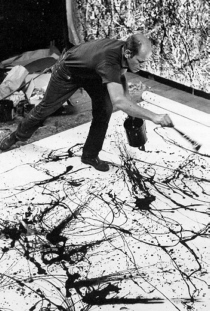Action painting
|
|
Action painting, sometimes called "gestural abstraction", is a style of painting in which paint is spontaneously dribbled, splashed or smeared onto the canvas, rather than being carefully applied. The resulting work emphasizes the physical act of painting itself.
The style was widespread in the 1940s and 1960s, and is closely associated with abstract expressionism (some critics have used the terms "action painting" and "abstract expressionism" interchangeably). A comparison is often drawn between the American action painting and the French tachisme.
The term was coined by the American critic Harold Rosenberg in 1952, and signaled a major shift in the aesthetic perspective of New York School painters and critics. While abstract expressionists such as Jackson Pollock and Willem de Kooning had long been outspoken in their view of a painting as an arena within which to come to terms with the act of creation, earlier critics sympathetic to their cause, like Clement Greenberg, focused on their works' "objectness." To Greenberg, it was the physicality of the paintings' clotted and oil-caked surfaces that was the key to understanding them as documents of the artists' existential struggle.
Rosenberg's critique shifted the emphasis from the object to the struggle itself, with the finished painting being only the physical manifestation, a kind of residue, of the actual work of art, which was in the act or process of the painting's creation.
Over the next two decades, Rosenberg's redefinition of art as an act rather than an object, as a process rather than a product, was influential, and laid the foundation for a number of major art movements, from Happenings and Fluxus to Conceptual and Earth Art
In an Aesthetic Realism Foundation[1] (http://www.aestheticrealism.org/) study of Pollock's painting, Number One 1948, Lore Elbel-Bruce shows how the aesthetic effect of this quintessential example of action painting arises from the way it is at once abandoned and accurate — that is, puts together the very opposites (http://www.terraingallery.org/IsBeauty.html) that "struggle" or are in conflict not only in the artist but in every individual.
Historical context
It is essential for the understanding of this movement to place it in historical context. A product of the post-war artistic insurgence, it developed in an era where quantum mechanics and psychoanalysis were beginning to flourish and change the entire Western civilizationís understating of the world and self-consciousness.
The preceding art of Kandinsky and Mondrian, had attempted to detract itself from the portrayal of objects and instead tried to tingle and tantalize the emotions of the viewer. Action Art took this a step further, using Freudís ideas of the subconscious as its underling foundations. The paintings of the Action Artists were not meant to portray any objects whatsoever and likewise were not meant to stimulate emotion. Instead they were meant to touch the observers deep in the subconscious. This was done by the Artist painting "unconsciously".
The unconscious act
This spontaneous activity was the "action" of the painter. The painter would let the paint drip onto canvases, often simply dancing around, or even standing on the canvases, and simply letting the paint fall where the subconscious mind wills, thus letting the unconscious part of the psyche express itself.
For example, in Jackson Pollokís paintings we can often find cigarette stubs. When he created his paintings, he would simply allow himself to slip into a trance in which no conscious act was to manifest itself; so if he had the instinctive impulse to throw his cigarette to the floor, he would do it, whether a sidewalk was beneath his feet, or even a canvas.
What we effectively experience is like observing someone smothering out their finished cigarette. Most of the time, the person will simply throw it to the ground without thinking what he is doing. What the Action Painters tried to portray was just this, an un-thought spontaneous action. As the viewer, we often see people stubbing out cigarettes without even thinking. And now, thanks to the Action Painters, what we see in their works is like the squashed remains of a cigarette on a side walk. We then think about the act we can recognises its manifestation as an unconscious act.
All this, however, is nothing we can explain or interpret, because it is only an unconscious manifestation.
Source: based (very) loosely on a lecture by Fred Orton at the Uni of Leeds
External links
- Fellow Drippers (http://reverent.org/movies.html). This videoclip analyzes action painting of Jackson Pollock and his fellow drippers.de:Action Painting

